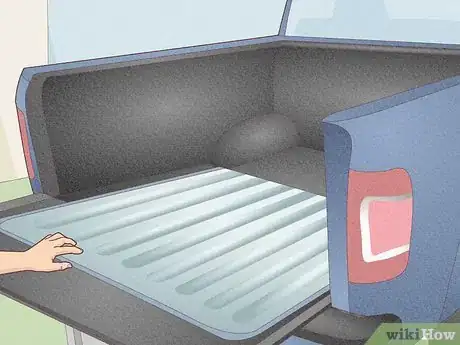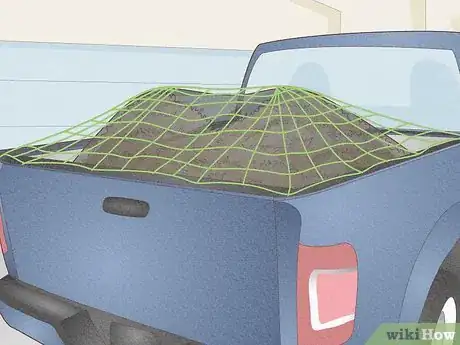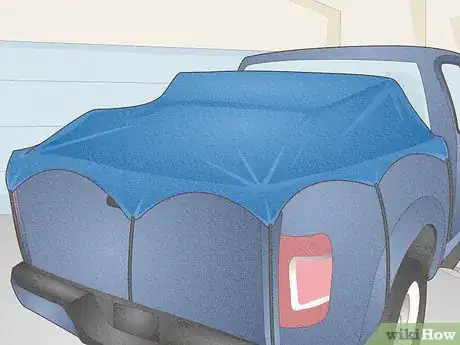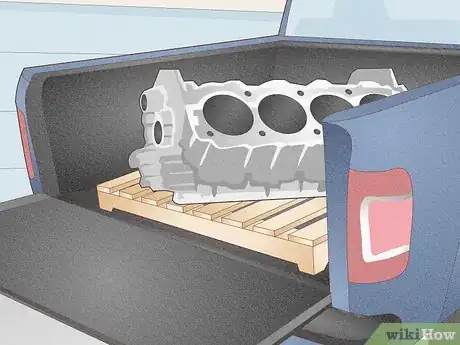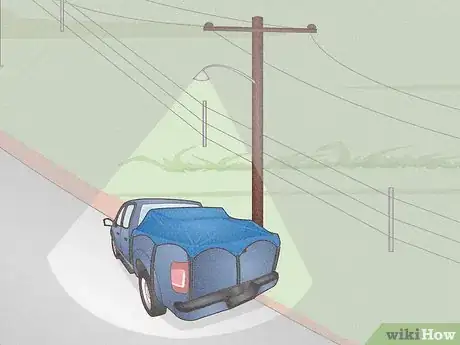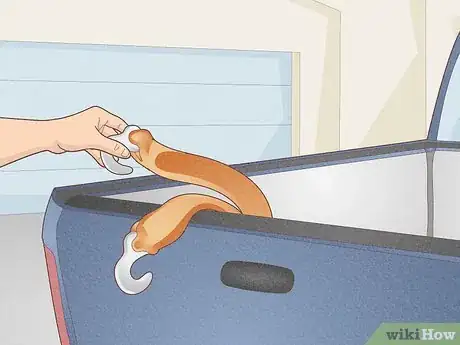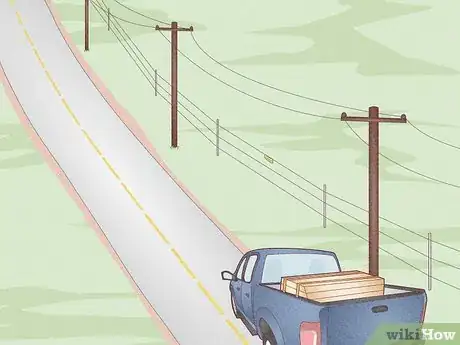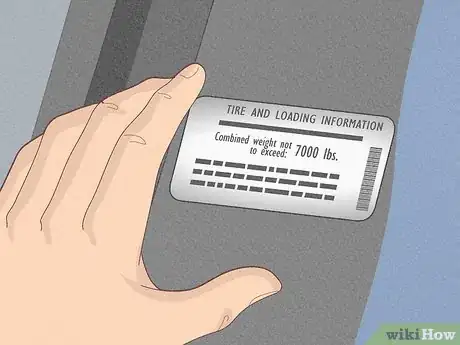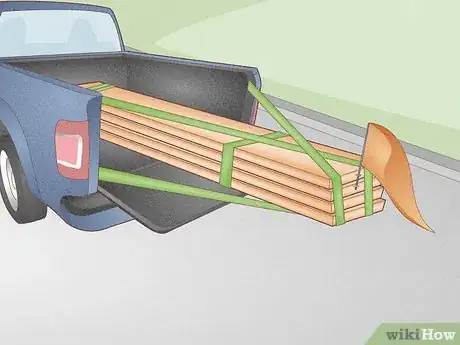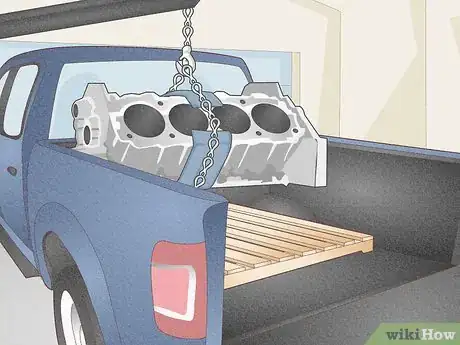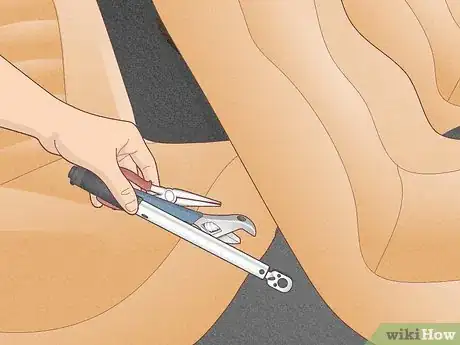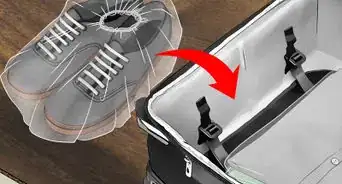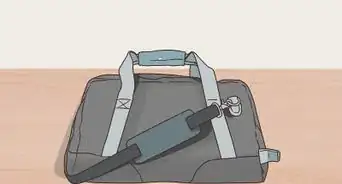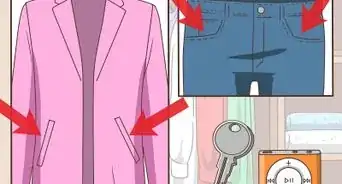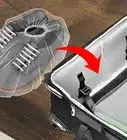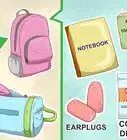X
wikiHow is a “wiki,” similar to Wikipedia, which means that many of our articles are co-written by multiple authors. To create this article, 15 people, some anonymous, worked to edit and improve it over time.
This article has been viewed 155,460 times.
Learn more...
Travelling in a pickup truck poses unique problems when gear and supplies must be left in the truck bed. You will need to keep your stuff dry in the event of rain, prevent it from blowing out, keep heavy objects from shifting about, and prevent lightweight things from being blown out. Here are a few ideas to help accomplish this.
Steps
-
1Prepare your truck to make it easier to secure your cargo. There are a number of different manufacturers and models of trucks, many of which have built in anchoring systems for cargo, but you may still find the need to add additional anchor points to suit your particular needs. Look at these options.[1]
- Install a bed rail. These options protect the rail of the truck bed from scraping and dents when heavy cargo is loaded over the side, may improve the appearance of the truck, and add tie down locations for large cargo which may be taller than the sides of the truck's bed.
- Install a non-skid bed liner. These are usually fabricated from polymer materials and have the added benefit of preventing damage to the bed's factory finish. They can be removable or factory applied, and will reduce load shifting on the slippery truck bed floor in braking and cornering situations.
- Install side rails. Most full-size pickups have factory formed post holes in the top of the bed sides. These are carryovers from a time when stake bodies were added to farm trucks for hauling hay or otherwise increasing the cargo capacity of the truck bed. You may want to haul trash or other light, bulky cargo, and can create your own temporary stake body by installing wooden posts in these holes and screwing horizontal rails along the length of your truck bed.
- Install additional tie down anchors in the bed floor. You may purchase D-rings or other similar aftermarket anchoring systems from auto parts stores and screw or bolt them directly to the truck bed floor for anchoring specific cargo. Keep in mind, drilling the original metal of your truck may encourage rust and devalue the vehicle in the event of resale.
- Keep a large cooler in the back of the truck for hauling groceries or other items back from the store. These are weather resistant, and keep things from blowing out while travelling.
- Purchase and install a large permanent toolbox, or tool boxes. These come in a remarkable number of configurations, but if you cannot find one that perfectly suits your needs, metal fabrication shops can custom build one to your specifications.
- Purchase and install a Tonneau Cover. This is the ultimate cargo protection, offering weather proofing, locking ability, and improved aerodynamics. Two drawbacks to this remedy are cost (they are expensive), and the fact they preclude hauling tall loads.
-
2Use cargo netting for hauling light materials like insulation or lawn trash. These nets are custom made and sized for specific bed sizes, and although they are a significant investment, made from nylon or polyester fiber, they resist rot and decay, are easily stored, and are very lightweight and easy to handle. Most come with hooks that attach to the seam underneath the sides of the truck bed, or have attachment anchors that fasten permanently to the truck's sides.[2]Advertisement
-
3Buy a tarp sized for your load. Truck beds vary in size, depending on whether it is a mid-size, compact, or full size pickup, and is short or long wheel-based. You will find tarps that have integral snaps that secure them, or you may want to anchor your tarp with bungee cords, which can be lapped over the sides of your truck's bed and hooked under the fenders.[3]
-
4Secure cargo to a pallet when it is loaded. A lot of freight hauled and delivered in tractor trailers rigs is loaded on wooden pallets to make loading and unloading with forklifts possible. You can often find these pallets at salvage yards or building supply stores free or available for a nominal fee. The wooden frame of a pallet is less likely to slip on the truck floor, and since they are fairly heavy and built of slats, you can secure the load directly to the pallet.
-
5Be aware that it is difficult to secure cargo in a truck bed in a fashion that will ensure its safety from a determined thief who has opportunity to access the truck unnoticed. Here are some simple things to make a thief's attempt to steal your cargo more difficult.[4]
- Park your truck in a well-lit area at night.
- Make sure your cargo is as invisible as possible, either by covering it with a tarp or storing it in some type of container.
- Park where your vehicle is visible to passers-by. Interstate Highway rest areas are a prime location for thieves, so try to park in the front, where people entering and leaving will discourage a thief.
- Lock the most valuable items inside the truck, and out of sight if possible.
- Consider buying a king-cab or quad-cab pickup so you have more interior room for storing your cargo.
- Travel directly to your destination when transporting cargo from one location to another. Stopping and shopping, sight-seeing, or for other activities exposes your cargo to greater risk either from theft or weather.
-
6Invest in quality ratchet straps for tying down heavy cargo. These are made of strong synthetic fiber, and paired with solidly anchored attachment points will hold even a heavy, unbalanced load tightly. Be sure to store these straps properly when not in use: sunlight, oil, dirt, etc, can slowly break down the fabric of the straps. This could cause them to become weakened and possibly fail.[5]
-
7Tie your cargo down' from at least two sides, securing ropes or straps to the load itself where possible, or crossing over the top in an X manner to prevent movement in all directions.
-
8Travel the smoothest, straightest path available. Avoiding curving or rough roads will decrease the chance your cargo will be subjected to extreme forces.
-
9Be aware of the load capacity of your truck. Vehicle suspensions and tires have a load rating (GVWR, or Gross Vehicle Weight Rating), found on the factory sticker on the edge of the driver's door panel. Never exceed this amount.[6]
-
10Tie a flag on unusually long loads, so other drivers will notice it overhanging the tailgate and avoid approaching too closely. Very long loads are more likely to shift, so you may have to tie a guying line to them to keep them stationary.
-
11Keep very heavy loads as far forward as possible to prevent the front of the vehicle from becoming light and making steering less effective and more difficult.[7]
-
12Consider placing valuable tools and other items behind the seats in the cab. This puts them out of sight, and out of the weather. When the truck doors are locked, this is about as safe as it gets.
Advertisement
Community Q&A
-
QuestionI would like to move 4-12 foot rolls of carpet (185 lbs each) from Minneapolis to Ontario with a pickup truck that has a 6 foot 6 inch bed and a cab that doesn't have an opening window or roof racks. Would it be legal, hanging out the back about 5 feet past the bumper in all states we pass through?
 Community AnswerYes; it is legal. One thing to keep in mind though, Canada will not allow you to bring things in by car unless you have previosly gotten a form from them and filled out what you are bringing. Also make sure they are not new, or you will have to pay sales tax for them again at the border.
Community AnswerYes; it is legal. One thing to keep in mind though, Canada will not allow you to bring things in by car unless you have previosly gotten a form from them and filled out what you are bringing. Also make sure they are not new, or you will have to pay sales tax for them again at the border. -
QuestionHow high can boxes be stacked in the back of the truck?
 Community AnswerThis would depend on the types of boxes, how heavy they are and how they are secured. For example; if they are not secured, they should be no higher than the sides.
Community AnswerThis would depend on the types of boxes, how heavy they are and how they are secured. For example; if they are not secured, they should be no higher than the sides.
Advertisement
Warnings
- Remember there are laws regarding hauling hazardous materials like fuels, compressed gas cylinders, or chemicals. You must have a MSDS for the item you are carrying, and some jurisdictions require you to display a special hazard sign clearly visible on the vehicle.⧼thumbs_response⧽
- Be aware of the danger of heavy cargo shifting in emergency braking, large items may be thrown through the back windshield if not securely fastened.⧼thumbs_response⧽
Advertisement
Things You'll Need
- Ropes, bungee cords, ratchet straps, or chains and binders.
- Tarps or cargo netting.
References
- ↑ https://www.youtube.com/watch?v=aFk45Sbye3o
- ↑ https://www.qld.gov.au/transport/vehicle-safety/transporting-loads/how-to-transport-loads
- ↑ https://www.qld.gov.au/transport/vehicle-safety/transporting-loads/how-to-transport-loads
- ↑ https://www.gopenske.com/blog/insights/cargo-theft-risk-dependent-on-where-truck-drivers-park
- ↑ https://www.youtube.com/watch?v=T1bRc4vkiBM
- ↑ https://www.youtube.com/watch?v=aFk45Sbye3o
- ↑ https://www.youtube.com/watch?v=aFk45Sbye3o
About This Article
Advertisement
